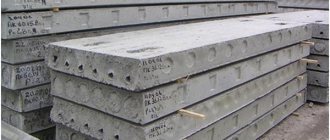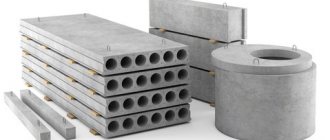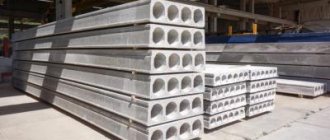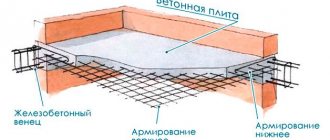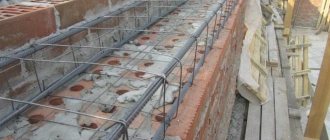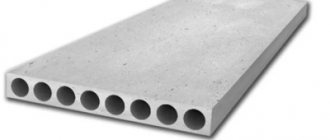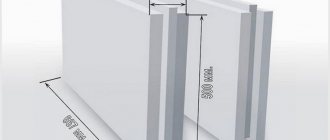Cutting concrete with a grinder. Determining the type of concrete. Selecting a blade, cutting type
When performing various construction works, it may be necessary to cut concrete. Since this material is very durable, this procedure has a number of nuances. In this article we will look in detail at how to cut concrete with a grinder.
Concrete cutting saws
For manual cutting of concrete, a concrete chain saw powered by gasoline or compressed air is often used. This lightweight and affordable tool does not require any special skills, so it is ideal for DIY construction work.
A chain cutter differs from a chainsaw for wood in that it has a more complex bar, which is equipped with special channels for water supply (due to which concrete is cut without dust) and a diamond chain.
This cutting set allows you to make cuts up to 30-40 cm deep, while the unit rotates 90 degrees, which is very convenient when creating niches, openings and other holes in concrete.
As a rule, gas cutters operate on a push-pull principle and are characterized by a high degree of protection against dust formation.
The concrete cutting saw is suitable for the following materials:
- Lightweight concrete (expanded clay concrete, wood concrete and other materials).
- Heavy concrete, which includes Portland cement, asphalt and other binders. You can also use a gas cutter to process monoliths if there is a weak reinforced frame.
- Silicate and ceramic bricks.
- Natural stones, porcelain stoneware and other artificial materials.
- Gypsum, plasterboard and limestone structures.
The gas cutter is also suitable for working on foam concrete and other cellular concrete (foam blocks, gas blocks, foam-gas concrete blocks and others).
- Laser cutting of concrete. The treatment is carried out by heating the surface with a laser. Due to the high cost of equipment, such processing is now practically not used.
- Plasma cutting of concrete. This method is also never used in private construction, but the cost of the equipment is lower. For plasma cutting, the material is also heated, but not by the laser, but by the compressed plasma arc.
Once you have decided how to cut concrete, you need to take into account several nuances of the work.
How to cut a floor slab?
Wall sawing machines
A wall saw is another concrete cutting tool that is equipped with a diamond blade. The unit consists of a motor, a hydraulic pump station, guide rails (for vertical and horizontal fixation), a cutting disk (with a diameter of more than 25 cm) and a control panel.
This type of machine provides higher cutting quality. In addition, the unit has the following advantages:
- The depth of the opening can reach up to 7.5 cm.
- Suitable for voluminous work of increased complexity.
- With the help of the unit, reinforced concrete is cut as quickly as possible.
- Low noise and vibration levels.
- Reliable fixation on the surface being treated.
- High cost of concrete cutting machine.
- To use the unit you must undergo training.
- Requires 380 W power supply.
What can't you do with slabs?
You cannot change the design support scheme
The simplest and most obvious example can be found on the Internet, when people take a slab that is larger than the span and, by releasing such a slab onto the street, solve the problem of organizing a platform for a balcony.
READ Chainsaw Stihl Ms 180 Won't Start
Here the first five slabs broke off along the wall, the last two slabs continue to resist, but they don’t have much longer left.
This is the transportation of floor slabs in a short KamAZ body. As I explained earlier, they broke off. If you look carefully, you can see that in the upper part of such slabs there is either no reinforcement or there are some small rods that clearly cannot resist such a large stretch. Therefore, in this case it is necessary to place a rigid cross-beam.
Where is the bending moment on that side and there will be tensile stresses in the slab. When we shift the support, the bending moment passes from bottom to top with a maximum at the point of support, and the tension in the slab will already be in the upper part. But in the upper part there is no reinforcement as in the formwork manufacturing technology and weak reinforcement in the formless manufacturing technology, so the slab breaks at the point of support.
And if you have done such a stupid thing as organizing such a platform in your home, then immediately take a grinder or a hammer drill and demolish this ledge, because sooner or later it will fall on someone’s head or you yourself will fall from it.
It often happens that the length of the slab is longer than the span. For example, a slab is 6 meters long, but we need to support it over a span of 4 meters. In this case, people cut the slab to the required size.
Cutting off a slab made using formwork technology can also lead to collapse!
As I already said, additional reinforcement is made in the formwork slabs in the support zones. By reducing the length, you cut off this reinforcement and there is a high risk of cracks.
Plates made using formless technology can be divided into parts.
To simplify the work, some people lay the slabs with their edges up and, for example, lay logs on them. I have already said that reinforced reinforcement occurs only in the ribs, there is only a light mesh at the top and it does not withstand bending loads and the slab breaks.
Is it possible to cut floor slabs?
Good afternoon Tell me, experts, is it possible to use hollow-core floor slabs cut to 0.6 m as floors on the 1st floor? The savings are good. Some say it’s possible, some say absolutely not. Thank you.
Galina, hello. You are absolutely right. You can safely shorten the hollow core slab to the required length without losing its strength. slab can withstand the design load from top to bottom, i.e. for deflection. The main reinforcement in the slab is located in the side parts of the slab and in the lower parts of the lintels between the voids. cut with a grinder using a 230 mm concrete disc. Saw through the top and ends to full depth. If possible, it is advisable to make a cut from the bottom as well. The unnecessary is fought off. The operation is not difficult at all. There shouldn't be any difficulties. I've done this more than once. Good luck.
You can use them if your room allows them; even if they are shortened, they do not lose their qualities. Feel free to use it in the construction of your home.
Cutting floor slabs
Of course you can, that's what it's designed for.
That is, I correctly understood that if the slabs are 6.0 m, and I need 5.4 m, then we can cut them, and they do not lose their properties, they are reinforced, i.e. tense?
Galina, hello. You are absolutely right. You can safely shorten the hollow core slab to the required length without losing its strength. slab can withstand the design load from top to bottom, i.e. for deflection. The main reinforcement in the slab is located in the side parts of the slab and in the lower parts of the lintels between the voids. cut with a grinder using a 230 mm concrete disc. Saw through the top and ends to full depth. If possible, it is advisable to make a cut from the bottom as well. The unnecessary is fought off. The operation is not difficult at all. There shouldn't be any difficulties. I've done this more than once. Good luck.
READ Is it possible to cut reinforcement with oxygen
Thank you very much to everyone, and especially to you, Sergey. You convinced us)
Tell me again! Does this apply to PKZh (U-shaped) slabs?
PKZh slabs are not prestressed. Therefore you can . Another thing is that, depending on the brand, they do not have a large load-bearing capacity. What brand do you have? There are PKZ from 1 to 5. 1 – maximum load 100 kg per m2. 5 – 500 kg per m2. Therefore, determine what kind of slab you have and consult with an architect (designer) whether they can be used.
In a U-shaped slab, the main strength elements (reinforcement) are located in the lateral vertical parts. Such a slab can be cut, and cutting is easier and more accurate. Just be sure, before starting to lay the walls of the upper floors on slabs, it is necessary to lay voids (U-shaped) between the top of the wall on which the slab and the thin upper part of the slab. I hope I explained it clearly. PS. While I was writing (distracted), Vladislav P. wrote his comment. I completely agree. Take the advice.
Thank you for your response. We decided to take hollow core slabs anyway. Great forum!
hollow core slabs can be cut to the length you need
Galina, a hollow core slab can be cut and it will not lose its strength.
These slabs are intended specifically for floors, even if they have been cut. The main thing is not to cut it with a sledgehammer, otherwise cracks will appear. And who was that sage who said NO?
Cutting floor slabs
Guys! Has anyone cut floor slabs (there are 58, I need to make 50) at home? Describe the process, how labor intensive? Replacement is expensive and time-consuming.
Oh, I pound there a lot. You'll get tired. You hammer out a large groove with a jackhammer, cut the rebar you come across with a turbine, then hammer it further. And so on until I got bored. And I got hooked very quickly. What kind of stove is it anyway? Is it already installed or not? In general, you should not cut reinforced concrete slabs. It is designed and arranged in a special way. It has supporting and supporting sections, where loads are distributed in a special way and special reinforcement is installed. By cutting the slab, you will cut off these sections and then support it with whatever you have to. In short, there is a very high probability that the slab will at least crack, or maybe simply collapse. Should not be doing that.
I was told that it is possible to use a grinder with a special circle or does this not happen?
Is it like at home? Have you got it packed? What does it rely on in this case? Brand? Describe in more detail.
Happens. Concrete and small reinforcement are like a knife through butter. There really is a lot of dust. Not just one milling cutter for concrete, but in combination with a high-speed turbine.
I saw how a slab was drilled along a line using hammer drills, and then beaten off. The biggest problem was with the fittings. The top was cut with a grinder, there was no way to get underneath. I had to carry a cutting torch.
If the length is a chore, but the length is no problem. In any case, you need a good sledgehammer.
Go to Molotok, they have any tool for rent, and they can advise you.
What kind of slabs? Where will they be used later? Most floor slabs have pre-tensioned reinforcement; they are not allowed. Cut off like two fingers on asphalt: “grinder”, abrasive wheels for it, marked “stone” or “concrete”
40 rubles apiece, for a slab in a circle, or one with diamond coating from 500 rubles, one is enough, cut 3-5 cm deep and with a sledgehammer, well, to be sure, you can make holes through 7-10 cm with a hammer drill, half an hour on the slab.
Grinder + diamond cutting disc + vacuum cleaner (to avoid dust). Normal disk from 1500 rub. Knock on Asya and I’ll tell you.
If a slab with prestressing reinforcement is cut, it is absolutely forbidden to cut it! If it’s ordinary, then it’s not advisable, but it’s possible. But in practice, many people cut and don’t really worry about it. Will there be a large load on the slab then??
if not mounted, then. 10 years ago, you lift the edge of the slab, place a 1/2 piece of pipe at the “edged edge”, use a crowbar to punch holes in the voids, then use a sledgehammer to finish off the ribs. You cut off the remaining aroma with a grinder. in one day, I personally broke 10 slabs, broke 2 sledgehammers, the crowbar did not break :)
Don't break the floor slabs - buy a new one. although nothing is particularly clear from the post
For some reason, the soap forum doesn’t report the answers, it’s strange. Now, in order. I'm going to build a house, probably 2 floors. The size along the axes is about 10 by 10. You don’t need more, the tax is *****, and it won’t seem like much to finish. For construction purposes, my father-in-law somewhere found used hollow-core floor slabs (removed when dismantling the house). There are a lot of them, more than 70 pieces. According to my calculations, I need a maximum of 36 with coverage of the basement and first floor, the load, IMHO, is small. But they are all 58*12. It’s very inconvenient to plan, we’ve already tried so hard to get normal rooms when laying slabs on load-bearing walls. It would be much easier if they were at least 50*12. A new slab (for example) size 50*12 costs about 5 thousand + delivery. Why bother throwing away about 200 rubles, they will be useful for a brick. The slabs lie in a stack on the site
I didn’t quite understand the connection between the layout of the rooms and the floor slabs. How much will the thickness of the walls be?
You build voids with stressed reinforcement for yourself, I wouldn’t risk shortening them. The experts will say an unequivocal “no”. Look for someone with whom you can exchange, x.. with him, even at a loss, otherwise you will live and think that you built a crypt for your family, a joke of humor, of course it won’t collapse all at once, but imagine, you built walls, a roof and some will crack.
creepy. associated with construction, as I do ventilation/air conditioning at various sites. a neighbor in the country bought an unfinished house, and he also played tricks with the slabs, and then she caved in. support columns were urgently erected. and one of the chocks once gave a lot of money if only we would run air ducts through the load-bearing crossbars. They refused, for fear of collapsing the house. This is an example I remembered of living and being afraid that the ceiling would collapse. In my opinion, it’s better to pay taxes, but be calm.
We cut the slabs almost diagonally with a grinder with a diamond blade, since we had to make a complex ceiling. But the slab was short, about 2 meters, and did not carry any load. There is a cool way out: for little money compared to the cost of a new slab and possible defects, go to a normal construction institute and after work, see with an assistant professor what can be sawed and what cannot. As a rule, such people also give so much practical advice along the way that the whole event justifies itself.
The point is not that you can’t cut it - you can cut it simply: an angle grinder, a respirator, a segmented disk for dry cutting on reinforced concrete - as long as there are no consequences.
Cutting holes in floor slabs
Most often, such holes are made for fastening stairs, wiring chimneys, and ventilation ducts. Of course, it is much better to lay a monolithic slab with holes than to cut holes in a hollow-core floor slab. However, sometimes making such holes is simply necessary. Please note that not only the integrity, but also the load-bearing capacity of the floor is compromised. So holes can only be made at the boundaries of two adjacent slabs.
- Make the markings.
- crosswise using a disc plate .
- Break up the concrete layer over the voids.
- Break the ribs with side kicks.
- Cut the reinforcement with a grinder.
- Fill technological voids
- Now the slab can be mounted on walls.
READ What You Can Make With a Circular Saw
Cutting hollow core slabs crosswise
It is advisable that the stove lies on a flat surface. Mark with chalk where the cutting line goes. Use a tape measure to avoid mistakes in measurements and markings. It is advisable to place a rigid support under the hollow-core floor slab, specifically in the area of the markings. The timber is perfect for this purpose. It is very important to place the timber exactly under the markings so that the concrete does not crumble when cutting. If you need to saw off a large piece, place a support under it as well.
Now make a cut along the mowing line using a circular saw. Use a sledgehammer to break the concrete in places where there are longitudinal voids. Solid ribs are much easier to break from the side. Hit the concrete carefully to avoid hitting the reinforcement. If you hit the steel frame hard, its adhesion to the concrete will be disrupted and the reinforcing bars may “slip” inside the slab.
When you have knocked the concrete off the reinforcement, take a grinder with a metal cutting disc and cut off all the rods. Then fill the slab voids with self-expanding concrete at the supporting depth (this is about 120-150 mm).
Cross cutting of hollow core slab
The slab must be laid on a flat surface. When measuring the slab, mark cutting lines with a pencil or chalk. A beam should be installed directly under the cutting site, this will avoid deformation of the slab or its coloring. When cutting out a large part, you need to place a support under it.
At the next stage, a saw enters the process, which is used to cut the slab along a pre-designated line. Next, all the concrete is broken with a sledgehammer. Concrete must be broken as carefully as possible; the impact must not be allowed to hit the reinforcement. This will compromise the strength of the structure, and the rods will begin to wobble inside the product.
After the hole is cleared of concrete, you need to take a grinder and carefully cut off all the reinforcement. After this, the voids in the slab are filled with self-expanding concrete to a depth of 15 centimeters.
What tools are useful for cutting slabs
It is better to cut hollow core slabs while they are still on the ground. Prepare your workplace, suit and tools:
- Circular Saw. A grinder will also work.
- Diamond blades for grinders or circular saws.
- Scrap.
- Sledgehammer.
- Roulette.
- Chalk for marking.
A universal diamond disc for reinforced concrete will easily cut the slab according to the specified parameters. It can handle both concrete and steel reinforcement. You cannot use a regular circle, because it will fly apart as soon as it touches the metal reinforcement.
Cutting in the longitudinal and transverse directions is very different in technique, so we will consider each option separately.
How to adjust the dimensions of a hollow-core floor slab before installation - step-by-step instructions
It is easier and safer to cut concrete products before installing concrete slabs - when they are still on the ground. Initially, you need to properly prepare the workplace and all the necessary tools.
For work you will need the following equipment and tools:
- circular saw (preferred) or grinder;
- sledgehammer;
- scrap;
- roulette;
- chalk for marking.
Photo 3. Specialized gas cutter
As a cutting tool, it is recommended to use a universal diamond disc for reinforced concrete, which can also cut reinforcement. An ordinary circle on concrete will fly apart when it hits a metal rod, which can lead to irreversible consequences.
Note! Cutting in the longitudinal and transverse directions differs slightly in their execution techniques, and cutting holes is a combination of both.
Is it possible to cut hollow core slabs?
Some construction projects require additional elements for reinforced concrete floor slabs. This applies to all types of floor slabs, including hollow core slabs. Order slabs with specific sizes. very expensive, and their production will take some time. It is much easier to cut existing standard slabs according to the markings. it possible to do this? Of course you can! In this article we will look at how to cut floor slabs lengthwise and crosswise , and what tools will be needed for this.
Cutting the floor slab 22cm
Adjusting the dimensions of a hollow core slab before installation
The work begins with preparing the work area, which includes the delivery of all the necessary tools, materials and accessories to the stove that needs to be dealt with. Remember about personal protective equipment. When cutting slabs, it is recommended to use goggles, a respirator and work gloves.
Place the first slab on the ground, holding the smooth side and the other. smooth to the left. move, using the plate in this position, on the corner of the piece that you can secure, moving straight and to the right. start by creating a strip as deep as one of the walls. If there is only 3 centimeters between the last slab and the last one, then choose to have the strip slightly closer to the bottom wall to leave a uniform space on both sides, instead of sacrificing a new series of slabs to store only 4.5 centimeters. If you decide to place end borders on the access to the room, you need to trim the border on the first slab in question. Based on the size of the wall on both sides of the door, you can immediately see whether there is a gap between this wall and the new strip formed in this manner. If this place is very large, then slabs will be used to fill it. Then secure a strip of tiles from the first strip to the slab, including the border. Once you reach a wall, hidden corner or pole, you need to cut the slab in question.
Some tips for processing hollow core slabs
Tip one: it’s better not to cut hollow-core floor slabs yourself. This is a labor-intensive, painstaking process that does not tolerate mistakes due to inexperience. Many factories for the production of concrete products provide services for sawing floor slabs. The cost of such work is low, so it is better to trust the professionals.
Tip two: when cutting concrete, it is better to use a circular saw rather than a grinder.
Tip three: carry out work wearing glasses and overalls. Protect your eyes from concrete dust. If possible, wear gloves and a respirator.
Sources:
https://zodchi42.ru/raznoe/mozhno-li-rezat-plity-perekrytija-pk.html https://trivita.ua/ru/blog/mozhno-li-rezat-pustotnyye-plity-perekrytiya
Hollow-core concrete slabs - floors.
7. In modern monolithic construction, the use of hollow concrete slabs for the construction of floors is justified by the following considerations.
Low thermal conductivity coefficient for the entire structure as a whole. The presence of voids in a monolithic structure increases the ability of the interfloor ceiling to retain heat. — High ability to withstand mechanical loads of torsion and deflection due to the reinforcement of the structure. — Increased sound insulation. — Reducing the weight of the floor.
In the photo: cutting a 2-pc floor slab with a diamond tool, slab thickness 220 mm. For reference: standard dimensions of a hollow core slab are 6600 millimeters long and 700 to 2400 millimeters wide. Diameter of hollow elements: 159 millimeters - marking slab 1PK, 140 millimeters - marking slab 2PK. The thickness of the above plates is 220 millimeters.

